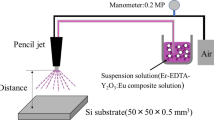Abstract
The objective of this work is to study the effect of deposited \(\hbox {CO}_{2}\) on the solid thermal conductivity of a cryogenic insulation system. Therefore, measurements were performed using a guarded hot plate apparatus at temperatures in the range from 80 K to 290 K in combination with a bellow acting as the sample containment. The unique experimental setup and sample preparation are described in detail. Furthermore, existing thermal models which are based on a superposition of thermal transfer due to radiation and solid thermal conductivity were modified to account for the thermal effects of deposited gases and the consequently increased solid thermal conductivity for a spherical powder. Measurements showed a significant increase of the solid thermal conductivity depending on the amount of \(\hbox {CO}_{2}\) that was provided for deposition–evacuation. 2.77 Vol-‰\(\hbox {CO}_{2}\) resulted in an increase of 5.5 % in the overall solid thermal conductivity. Twice this amount (5.54 Vol-‰\(\hbox {CO}_{2}\)) and four times this amount (11.1 Vol-‰\(\hbox {CO}_{2}\)) resulted in an increase of \(8.8\,\%\) and 14.1 % in the overall solid thermal conductivity, respectively. Due to additional temperature sensors, it was possible to measure the effective thermal conductivity in different layers of the insulation material. Thus, a significant change in the innermost layer of \(75\,\%\) was measured for the solid thermal conductivity comparing the evacuated sample with the \(\hbox {CO}_{2}\)-loaded (11.1 Vol-‰\(\hbox { CO}_{2})\) sample.










Similar content being viewed by others
Notes
State of the art technology from different sectors included icefuel® will develop a system for transport, storage and conversion of energy, that is capable of buffering fluctuating peak load and supporting balance between power generation and power demand (for more information see www.icefuel.de).
References
icefuel\(^{\textregistered }\)—Integrated Cable Energy System for Fuel and Power, Project Homepage, Internet, http://www.icefuel.eu. Accessed 11th May 2008
J. Fricke, in 7th International Vacuum Insulation Symposium 2005 (Empa Dübendorf, Switzerland), pp. 5–14
M.G. Kaganer, Thermal Insulation in Cryogenic Engineering (IPST Press, Jerusalem, 1969)
H. Schwab, U. Heinemann, A. Beck, H.-P. Ebert, J. Fricke, J. Therm. Envel. Build. Sci. 28(4), 319–326 (2005)
R. Siegel, J.R. Howell, Thermal Radiation Heat Transfer (McGraw-Hill, New York, 1972)
Y.S. Touloukian, R.W. Powell, C.Y. Ho, P.G. Klemens, Thermophysical Properties of Matter (IFI/Plenum, New York, 1970)
L.A. Koloskova, I.N. Krupskii, V.G. Manzhelii, B.Ya. Gorodilov, Yu.G. Kravchenko, Fiz. Tver. Tela 16, 3089, 1974 [Phys. Solid State 16, 1993 (1974)]; Fiz. Kondens. Sost., Institute for Low Temperature Physics and Engineering, Kharkov, USSR, No. 31, 69, 1974
U. Heinemann, J. Hetfleisch, R. Caps, J. Kuhn, J. Fricke, in Proceedings of the Eurotherm Seminar No. 44 (Advances in Thermal Insulation, Espinho-Portugal, 1995), pp. 155–164
M. Geisler, J. Wachtel, F. Hemberger, T. Schultz, S. Vidi, H.-P. Ebert, Int. J. Thermophys. 29, 1385–1394 (2008)
Norm, Industrial Platinum Resistance Thermometer Sensors (IEC 60751:1983 + AMD 1:1986 + AMD 2:1995), German version EN 60751:1995 + A2:1995 (Beuth Verlag GmbH, 1996)
Potters Industries Inc., Datasheets, Internet, http://www.pottersbeads.com/markets/PolySpheriglassASpecs.asp. Accessed 11th April 2008
M.T. Nguyen, Ph.D. thesis (Technical University Dresden, 2004)
J. Manara, Ph.D. thesis, (University Wuerzburg, 2001)
H.-P. Ebert, V. Bock, O. Nilsson, J. Fricke, High Temp. High Press. 25, 391 (1993)
C. Laa, C. Hirschl, J. Stipsitz, AIP Conf. Proc. 985(1), 1351–1358 (2008)
J. Fricke, R. Caps, E. Hümmer, G. Döll, M.C. Arduini, F. De Ponte, Insulation Materials: Testing and Applications. ASTM STP 1030 (ASTM, West Conshohocken, 1990), pp. 575–586
B.E. Scholtens, J.E. Fesmire, J.P. Sass, S.D. Augustynowicz, K.W. Heckle, AIP Conf. Proc. 985, 152–159 (2008). doi:10.1063/1.2908517
W. Johnson, J. Fesmire, B. Meneghelli, Cryopumping field joint can testing, AIP Conf. Proc. 1434, pp. 1527-1533; doi:10.1063/1.4707082
M. Geisler, PhD thesis, Thermische Charakterisierung selbstevakuierender Kryodämmmaterialien durch Ausfrieren von Kohlenstoffdioxid als Füllgas, 2011, Würzburg
Acknowledgments
The scientific investigations have been carried out within the research project “\(icefuel^{\textregistered }\)”. This joint research project started in July 2006 and is supported by the Bundesministerium für Bildung, Wissenschaft, Forschung und Technologie (BMBF), Federal Republic of Germany, in Bonn (FKZ 16SV2357).
Author information
Authors and Affiliations
Corresponding author
Rights and permissions
About this article
Cite this article
Geisler, M., Ebert, HP. Thermal Characterization and Effect of Deposited \(\hbox {CO}_{2}\) on a Cryogenic Insulation System Based on a Spherical Powder. Int J Thermophys 37, 80 (2016). https://doi.org/10.1007/s10765-016-2087-4
Received:
Accepted:
Published:
DOI: https://doi.org/10.1007/s10765-016-2087-4



